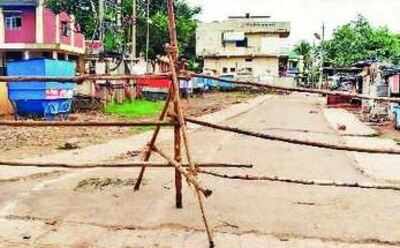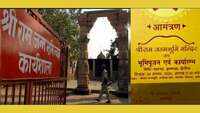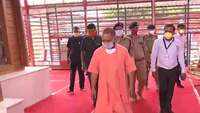
BELAGAVI: With cases surging past the 17,000-mark, the heathcare system in north Karnataka districts, mediocre in the best of times, is now crumbling under the strain of the pandemic. Many severely ill patients do not have access to ICU or ventilator support, while even beds for the moderately ill are at a premium and ambulances in short supply.
One reason experts and doctors say is that the government is focusing on dealing with every active case and this is draining resources and hindering critical care. They say most deaths in districts like Kalaburagi, Belagavi, Bidar, Dharwad, Gadag and Raichur could be prevented since most die due to delay in treatment or non-availability of ventilators. The total active cases in NK on Sunday stood at 17,024, while 20,630 people have recovered and 688 have died.
However, when contacted Belagavi district health officer (DHO) Shashikanth Muniyal suggested there is no dearth of equipment or facilities. He said there are a total 60 ventilators in the district of which, three apiece have been given to nine taluks. There are 95 government ICUs (intensive care unit) beds and more than 400 private ICU beds, while there a total of 6,000 private and government beds available.
But ground realities are very different. A week ago, a video of an elderly woman at Belagavi Institute of Medical Sciences, writhing in pain for want of a ventilator, went viral. The woman also claimed the hospital was not providing sufficient food. She later died. There was also the case of an ambulance being set on fire by angry kin of a patient who died.
The situation is similar in other districts. A family member of a patient in Raichur told ToI, “A relative of mine who had breathing problems besides other Covid symptoms refused to get admitted at RIMS (Raichur Institute of Medical Sciences) because of the poor facilities there. The patient is currently at home. He cannot afford treatment at a private hospital.”
Dr Maqsood Chanda from Bidar, who has been working with the government, admitted there is a lack of human resources, ventilators and oxygen cylinders. “The government is unnecessarily providing beds for asymptomatic and mildly symptomatic patients who can stay in home isolation,” Dr Chanda said. “Over 85% are asymptomatic/mild and 15% are moderate/severe. ICU is required for 1-2% of patients and the government must focus on this 2%.”
Ashok Chandaragi, an activist, said the health department should fit PHCs with oxygen and ICU beds. “Shifting patients to district headquarters from villages is costing valuable time and non-availability of ambulances is a huge problem. The government should also allow asymptomatic/mild patients to buy medicines from drug stores. This will ease panic and save lives.”
Dr Srinivas Kakkilaya, a medical practitioner, said the government should track happy hypoxia patients by sending Asha workers to homes. This will ease the burden on the system, he said.
One reason experts and doctors say is that the government is focusing on dealing with every active case and this is draining resources and hindering critical care. They say most deaths in districts like Kalaburagi, Belagavi, Bidar, Dharwad, Gadag and Raichur could be prevented since most die due to delay in treatment or non-availability of ventilators. The total active cases in NK on Sunday stood at 17,024, while 20,630 people have recovered and 688 have died.
However, when contacted Belagavi district health officer (DHO) Shashikanth Muniyal suggested there is no dearth of equipment or facilities. He said there are a total 60 ventilators in the district of which, three apiece have been given to nine taluks. There are 95 government ICUs (intensive care unit) beds and more than 400 private ICU beds, while there a total of 6,000 private and government beds available.
But ground realities are very different. A week ago, a video of an elderly woman at Belagavi Institute of Medical Sciences, writhing in pain for want of a ventilator, went viral. The woman also claimed the hospital was not providing sufficient food. She later died. There was also the case of an ambulance being set on fire by angry kin of a patient who died.
The situation is similar in other districts. A family member of a patient in Raichur told ToI, “A relative of mine who had breathing problems besides other Covid symptoms refused to get admitted at RIMS (Raichur Institute of Medical Sciences) because of the poor facilities there. The patient is currently at home. He cannot afford treatment at a private hospital.”
Dr Maqsood Chanda from Bidar, who has been working with the government, admitted there is a lack of human resources, ventilators and oxygen cylinders. “The government is unnecessarily providing beds for asymptomatic and mildly symptomatic patients who can stay in home isolation,” Dr Chanda said. “Over 85% are asymptomatic/mild and 15% are moderate/severe. ICU is required for 1-2% of patients and the government must focus on this 2%.”
Ashok Chandaragi, an activist, said the health department should fit PHCs with oxygen and ICU beds. “Shifting patients to district headquarters from villages is costing valuable time and non-availability of ambulances is a huge problem. The government should also allow asymptomatic/mild patients to buy medicines from drug stores. This will ease panic and save lives.”
Dr Srinivas Kakkilaya, a medical practitioner, said the government should track happy hypoxia patients by sending Asha workers to homes. This will ease the burden on the system, he said.

Coronavirus outbreak
Trending Topics
LATEST VIDEOS
City
 'Wanted to teach Hindus a lesson' using political power, ex-AAP councillor Tahir Hussain confesses
'Wanted to teach Hindus a lesson' using political power, ex-AAP councillor Tahir Hussain confesses  48-hour countdown to Ram Mandir Bhumi Pujan in Ayodhya; invitation cards sent
48-hour countdown to Ram Mandir Bhumi Pujan in Ayodhya; invitation cards sent  UP CM Yogi Adityanath takes stock of preparations in Ayodhya ahead of Ram Temple bhumi pujan ceremony
UP CM Yogi Adityanath takes stock of preparations in Ayodhya ahead of Ram Temple bhumi pujan ceremony  J&K: Army Jawan abducted from Kulgam, vehicle set ablaze; massive search operation launched
J&K: Army Jawan abducted from Kulgam, vehicle set ablaze; massive search operation launched
More from TOI
Navbharat Times
Featured Today in Travel
Quick Links
Kerala Coronavirus Helpline NumberHaryana Coronavirus Helpline NumberUP Coronavirus Helpline NumberBareilly NewsBhopal NewsCoronavirus in DelhiCoronavirus in HyderabadCoronavirus in IndiaCoronavirus symptomsCoronavirusRajasthan Coronavirus Helpline NumberAditya ThackerayShiv SenaFire in MumbaiAP Coronavirus Helpline NumberArvind KejriwalJammu Kashmir Coronavirus Helpline NumberSrinagar encounter
Get the app



